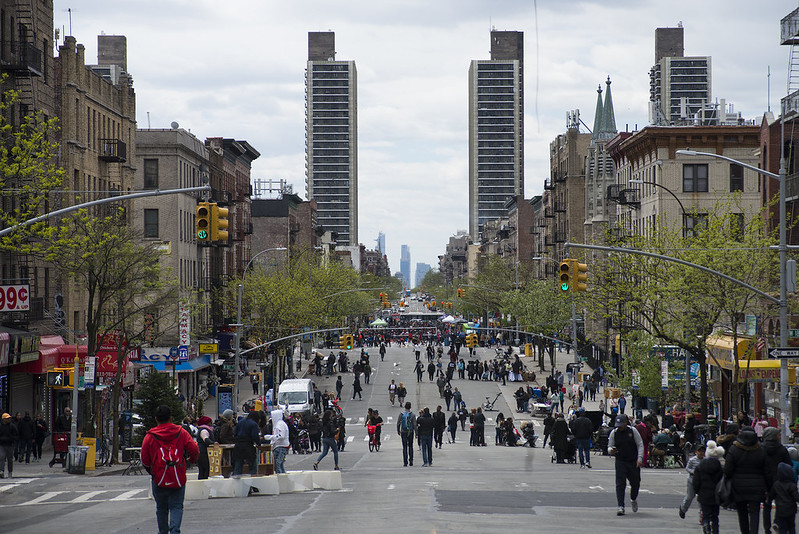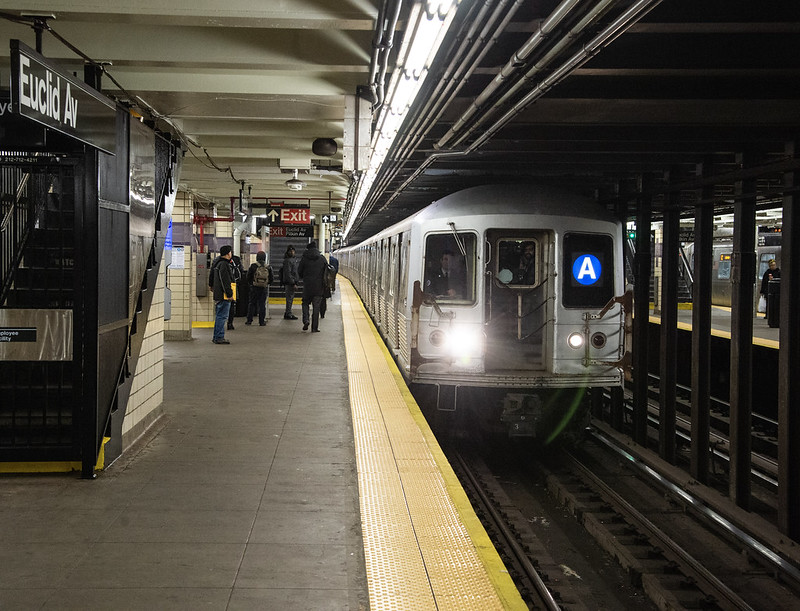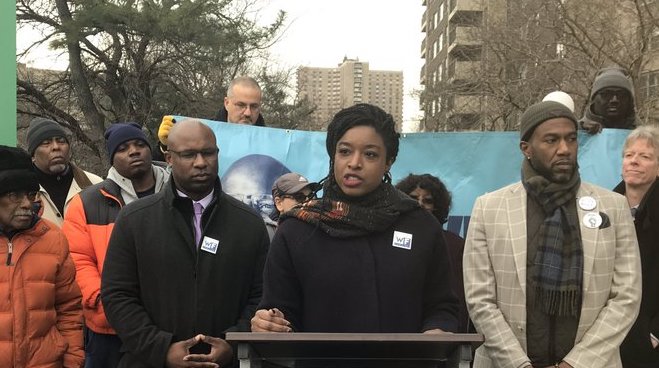Open City Streets to Promote Social Distancing and Public Health

Car free day 2019 (photo: Jeff Reed/City Council)
The COVID-19 pandemic is posing an unprecedented challenge to New Yorkers. As we face this surreal moment together, we are also learning what it means to practice “social distancing” — and, inevitably, it has not gone perfectly. Case in point: we have taken to city parks in astonishing numbers, creating crowds and density that risk spreading the very virus we’re trying to fight.
Is it possible for New Yorkers to maintain a safe distance and “flatten the curve” without foregoing fresh air? Put another way, can we practice good public health without sacrificing personal physical and mental health?
Yes, we can: by repurposing some of our currently underutilized streets into pedestrian boulevards, we can take the pressure off our park space and reduce pedestrian density.
While our parks become more crowded -- Spring is also upon us, after all -- New York City’s streets are experiencing an extraordinary decline in vehicle traffic. According to the New York Times, weekday afternoon rush-hour traffic recently moved 36 percent faster, and carbon monoxide emissions fell more than 50 percent.
The shrinking street space used by cars and trucks means we can dedicate more space to pedestrians, reduce the crowding in our parks, and allow New Yorkers to get a respite from the indoors while keeping a safe distance. To do this, city government should identify specific streets on which non-essential vehicles are prohibited, and dedicate that space to pedestrians.
We already know how to achieve this. For three Saturdays in the summer, New York City kicks cars out of a nearly seven-mile stretch of Park Avenue in Manhattan, from downtown to 72nd Street on the Upper East Side, and makes a car-free connection to Central Park along 72nd Street. That’s a model to build on now. And we wouldn’t be alone in expanding a summer streets program to promote social distancing. Philadelphia, for example, recently closed a long stretch of its bustling MLK Jr. Drive indefinitely to vehicular traffic.
Local leaders are beginning to see the wisdom in pedestrianizing streets. On March 20, New York City Council Speaker Corey Johnson called for a “Summer Streets like program to give more room for children and adults to use our streets free from cars to allow for the social distancing needed.” Two days later, on Sunday, Governor Andrew Cuomo called on city leaders to reduce overcrowding in city parks, including “open[ing] streets to reduce density.” “That's where people should be — in open space areas, not in dense locations," the governor added.
New Yorkers must remember that staying home is absolutely imperative. But, when going outside, we should heed the governor’s recent executive order: “individuals should limit outdoor recreational activities to non-contact and avoid activities where they come in close contact with other people.” In other words, solitary exercise can promote physical and mental health, but no one should risk spreading coronavirus by engaging in group recreational activities.
The health benefits of even a short walk outside cannot be overstated. Decades of data underscore the correlation between physical activity and improved cardiovascular, bone, and lung health. Exercise has also been correlated with a decreased rate of depression and improved mental health. While there is no definitive data that outdoor recreation is superior to indoor activity, New York City gyms are (appropriately) closed and many New Yorkers barely have room for a futon, let alone space to exercise, in their apartments. Furthermore, outdoor exposure itself may have benefits on sleep, cognitive function, and mental health.
To be clear: recommending solitary recreation does not equate with outdoor social gatherings. Outdoor recreation should still be limited in time (common recommendations of 30-45 minutes of aerobic activity 3-5 times per week should be sufficient) and social distancing remains the first priority. Furthermore, for older adults and those with significant preexisting conditions the risk of any outdoor exposure right now may still outweigh the potential benefits. Even with excellent hand hygiene and preventative techniques, COVID-19’s transmissibility and surface stability make it dangerously easy to contract.
The city should not view pedestrianized streets in a vacuum. Rather, city leaders should take a holistic view of how our streets can both help New Yorkers run essential errands and get fresh air—at a safe distance.
First, we need more protected bike lanes, particularly for the delivery cyclists we ask so much of while restaurants close to dine-in customers. Second, we need to mitigate existing pedestrian crowding. The narrow pedestrian paths of the Central Park transverse roads connecting the Upper West Side and Upper East Side are a notable example. With vehicle usage depressed, the city should create wider spaces for pedestrians and cyclists.
Third, the city’s bridges need attention. On the Queensboro Bridge, cyclists and pedestrians have long shared the same extremely crowded path. The Department of Transportation can reduce that density by opening the bridge’s South Outer Roadway to pedestrians. (Disclosure: one of us, Billy Freeland, is a member of Manhattan Community Board 8, which recently asked DOT to study the feasibility of such a path. Billy is writing here in his individual capacity.)
Any plan to pedestrianize streets should be mindful of other vital needs. In addition to our moral obligation to ensure a protected bike lane that treats delivery cyclists with dignity and respect, pedestrianized spaces must ensure access for emergency vehicles. The city will also need to accommodate delivery trucks that stock supermarkets and other open stores, perhaps with dedicated delivery times early and late in the day. The Department of Transportation is well-equipped to consider and address these concerns, as it has done before.
We are all in this together. And we are all figuring this out together. Let’s look out for our neighbors, practice social distancing, and find creative ways to remain connected. And, yes, let’s open our streets to people.
***
Billy Freeland is an attorney and Democratic activist, and on Twitter at @policyjunkie. Dr. Philip Solomon is a geriatrician at a New York City health system.
***
Have an op-ed idea or submission for Gotham Gazette? Email This email address is being protected from spambots. You need JavaScript enabled to view it.
New York Mass Transit System on Verge of Going Broke, Needs Bailout Quickly

Subway ridership has plunged during the coronavirus outbreak (photo: Marc A. Hermann/MTA NYCT)
Patrick Foye, the chair of the Metropolitan Transportation Authority and therefore the leader of the city’s subway and bus systems, sent a letter to the local Congressional delegation on March 17 stating that the MTA faced financial calamity and seeking $4 billion in federal aid.
The MTA’s cash reserves are small, meaning it will go broke very quickly because of massive revenue losses (in this case resulting from the impact of the coronavirus outbreak). By going broke I mean unable to meet payroll and pay bills. More than 60% of the MTA’s expenses are for labor, nearly all of it under contract, and those workers need to keep getting paid.
In Foye’s letter to Congress, he reported the authority has drops of 60% in subway ridership, 49% in bus ridership, 90% in Metro-North ridership, and 67% ridership on the Long Island Railroad.
On March 19, MTA New York City Transit President Sarah Feinberg reported on WPIX-11 that subway ridership had dropped 71% from the same date a year prior. For the city subway and bus systems, that means MTA NYC Transit is still carrying 3 million daily rides, instead of the normal 7 million rides per weekday. Three million rides is still a lot of people and the system has to keep operating to bring health care workers, first responders, and others essential for society’s basic services, including in the utility industry, supermarkets and grocery stores, banking, some retail, and essential government functions.
Foye’s letter also cited a potential collapse of the $6 billion in taxes and fees directly dedicated to the authority that derive from economic activity in the metropolitan area. The prospect of rapid revenue losses puts the MTA in an impossible situation — it must keep paying its employees to operate the trains and buses, but its cash flow may be insufficient to meet payroll in the near future. Payroll, pension, and health and welfare also don’t include paying the fuel and electric bills, buying supplies, or the $250 million a month needed to pay interest on the borrowed funds that sustain the capital program and assets already put in place.
The MTA has only about $560 million in general reserves, about three-quarters of which is set-asides for retiree health and welfare, which the MTA is obligated to pay but, unlike the pension system, are unfunded. The MTA makes these payments for the retirees in cash out of the operating budget but they rise every year, though it has tried to accumulate some reserves for this purpose.
An analysis of the overall MTA budget shows, however, that the combined ridership and tax revenue financial losses by the end of April would bring a shortfall for the MTA of around $500 million from the $1.4 billion sum needed to pay one month’s MTA expenses. The monthly ridership revenue is about $500 million, and it is nearly six weeks to the end of April. A 50% drop would mean a loss of at least $375 million over that period. Foye’s reports indicate the ridership losses exceed 50%.
The dedicated taxes and fees also run about $500 million a month, and even a 20% drop over the next six weeks would result in a loss of $150 million. With a revenue shortfall by the end of April of $500 million, the authority would need all of its reserves to meet payroll and the rest of its bills and would start coming up short in May. The table below, taken from Volume I of the MTA December budget, p. 14, provides the data to make the calculations.
|
A FINANCIAL SNAPSHOT OF THE MTA |
|||||||||
|
REVENUE SOURCE (millions) |
EXPENSE CATEGORY (millions) |
||||||||
|
Farebox |
$6,486.00 |
Payroll |
$5,525 |
||||||
|
Tolls |
$2118 |
Overtime |
$896 |
||||||
|
Taxes |
$6182 |
Health & Welfare |
$2171 |
||||||
|
State & Local |
$613 |
Pension |
$1467 |
||||||
|
Other Revenue |
$682 |
Other Labor |
$509 |
||||||
|
Funding Agreements |
$718 |
Non-Labor |
$4156 |
||||||
|
Other |
$203 |
Debt Service |
$2843 |
||||||
|
Total |
$17,003 |
Total* |
$16,991 |
||||||
(*includes adjustments of ($577 million) from use of reserves, etc.)
Getting bailed out by City and State government won’t work. The City and State are anticipating the major downturn in the economy severely affecting their own budgets. A new report by the State Comptroller’s office shows the State’s tax revenue could drop $4-7 billion below predictions from when the governor’s executive budget was released in mid-January.
Both governments have $6 billion or more in reserves and short-term borrowing powers, but will need these funds to sustain other government employment, the health care system, and public assistance, and will likely soon need to be bailed out by the federal government themselves. At best the City and State could squeeze out about $250 million each in the month of May for the MTA, but after that the federal government has to step in. Only the Feds have the unlimited borrowing power to stem the tide. The MTA will need large government cash infusions within the next several months.
The Capital Plan and Congestion Pricing
Both Governor Cuomo and Mayor de Blasio recently recognized the Trump administration was likely stalling the approval of congestion pricing, the $15 billion centerpiece of the long-term funding of the next MTA capital plan, which includes many important projects like re-signaling several subway lines. The Federal Highway Administration has to approve the State’s plan because our roads affect the Interstate Highway System.
Perhaps the national impulse to drop partisan rancor might diffuse hostility on this point. Maybe. New York might still need to await a Democratic victory this fall to assure that, sooner or later, congestion pricing will be approved by the presidential administration. But between Donald Trump and the new coronavirus, some parts of the MTA capital plan will likely be delayed until 2022 or beyond. The MTA’s capacity to operate needs help right now.
***
Jim Brennan was a member of the New York State Assembly for 32 years, where he chaired four committees. On Twitter @JimBrennanNY.
***
Have an op-ed idea or submission for Gotham Gazette? Email This email address is being protected from spambots. You need JavaScript enabled to view it.
Rolling Back Bail Reform Amid Coronavirus Outbreak Would Be Additionally Irresponsible

Sochie Nnaemeka, the author (photo: @sochiesays)
In moments of crisis, we see what our leaders value. Over the past week, coronavirus has spread to Rikers Island. Our state should be focused on keeping detained New Yorkers and correctional workers safe and healthy. Instead, elected officials may roll back bail reforms in response to fear-mongering by opponents of the new law. If our leaders in Albany choose to reduce the number of people eligible to await their trial from home, the jail population could grow during a dangerous pandemic. We must put human safety over punishment and refuse any changes to the bail system.
For too long, New York’s “justice” system disproportionately kept innocent black, brown, and low-income people in cages before even being convicted—all because they were too poor to buy their freedom. While the wealthy were always able to walk free, these communities were caught in an endless cycle of punishment. It took decades of grassroots leadership and activism led by black and brown organizers to finally change a blatantly racist, classist system in meaningful ways.
Republicans, District Attorneys, and law enforcement that have a vested interest in past and present inequities are doing anything they can to claw back their power to incarcerate even more people. And some state officials are already caving to the fear-mongering by proposing regressive bail rollbacks.
There is nothing more cynical or cruel than choosing to put more people in jail during a pandemic.
Behind the negative headlines, we know there are tens of thousands of lives being changed for the better because of the new bail reforms. All across the state, we are hearing stories of New Yorkers who can now continue their lives and care for their children, rather than senselessly languish in jail and have their lives upended. People who need treatment for substance use or mental illness can get access to the support they need, rather than sitting in jails that have little to no health services.
Bail changes should be left alone regardless of any new developments unrelated to their efficacy. But to roll back bail reform in the midst of this pandemic would mean the state considers certain people’s lives expendable, including thousands of people whose only crime is being poor.
At a time when Governor Cuomo is telling New Yorkers to remain home, stay six feet away from others, and avoid crowds, he cannot simultaneously support sending more New Yorkers to crowded, unsafe jails. Our elected officials should instead focus on releasing vulnerable New Yorkers who are at increased risk of illness and reducing the jail population.
What if the New York State Legislature committed itself to building a state that treated all New Yorkers with dignity and equal justice? As head of the New York Working Families Party, I know our members expect progressive leaders to govern with courage and moral clarity — not to operate within the same fear-based framework that maintained a racist justice system for so long. In this moment of crisis, we’re calling on New York state leadership to reject the politics of fear and put the health and welfare of all New Yorkers, including some of the most vulnerable, first.
***
Sochie Nnaemeka is New York Working Families Party State Director. On Twitter @sochiesays & @NYWFP.
***
Have an op-ed idea or submission for Gotham Gazette? Email This email address is being protected from spambots. You need JavaScript enabled to view it.




